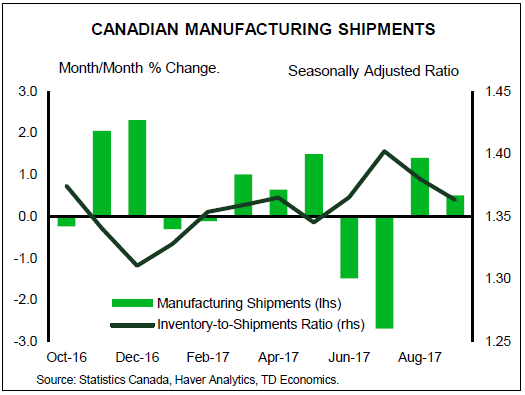U.S. Highlights
- The Federal Reserve meets next week and is near-universally expected to raise interest rates by 25 basis points, bringing the target for the fed funds to a range of 1.25% to 1.5%.
- The U.S. labor market continues to make progress with 228k jobs added in November. Given the current rate of job creation, it is only a matter of months before the unemployment rate pushes below 4%.
- The American economy is likely to continue its winning streak. Even without tax cuts, 2018 is likely to see growth around 2.5%. With increasing prospects for fiscal stimulus to push growth even higher, the Federal Reserve will continue to remove monetary accommodation.
Canadian Highlights
- October trade data showed real exports increasing and imports dropping, setting up for net trade to make a sizeable positive contribution to economic growth in the fourth quarter.
- Housing starts surged in November, but building permits suggest that some cool-off in building activity is likely going forward. November data from local real estate boards was a mixed bag with strength in Toronto but some moderation in Vancouver.
- The Bank of Canada stood pat on rates but was surprisingly dovish in the accompanying statement, causing the Canadian dollar to sell off and throwing some cold water on near-term rate hikes.
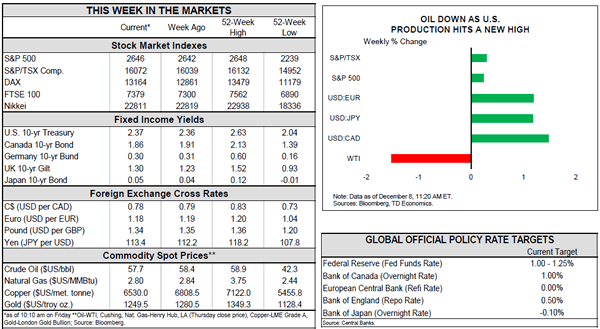
U.S. – The Fed Can’t Ignore A 3-Handle On Unemployment
As the Federal Reserve meets next week to decide interest rate policy for the final time in 2017 it is faced with ebullient financial markets and an economy that is operating increasingly close to full capacity. With November’s gain of 228k jobs, the streak of positive job creation entered its 86th month. The unemployment rate in November held steady at 4.1% (a seventeen year low), but with job growth trending above 200k, it is only a matter of months before it pushes to lows not seen since the 1960s.
Monetary policy is set with an eye to the future. As a thought experiment, assume that the rate of job creation continues at around its current pace of 200k a month. Given demographics, this is more than double the pace needed to keep up with labor market growth. Should this continue over the next year it will push the unemployment rate to just 3.4% – the lowest rate on record (data goes back to 1947).
While there are some doubts about the strength of the relationship between unemployment and inflation, an unemployment rate that begins with a three handle is certain to raise eyebrows. The unemployment rate is already below the FOMC’s assumed neutral level of 4.6%, and other broader measures of labor market slack, such as long-term unemployed and the U-6 measure of labor underutilization, continue to trend lower.
The hope is that employer demand for labor will draw discouraged workers back into the labor force, but the pool of such potential workers is dwindling. Relative to the population, the share of people outside of the workforce (not actively searching for a job), who want a job now is at the same rate it was prior to the recession (Chart 1). The employment to population ratio of core working-aged women (between 25 to 54) has already regained its pre-recession peak (Chart 2). The ratio is still lower for men, but it has been steadily declining for no less than seventy years. Subtracting the long-run trend, the ratio does not appear all that abnormal.
Even without tax cuts, the U.S. economy appears likely to continue its winning streak. Growth in the fourth quarter is tracking close to 3%. With supportive financial conditions, economic growth in the range of 2-2.5% appears likely over the next year. Into this environment, Congress looks increasingly likely to pass a tax cut that will raise the deficit and add as much as $1 trillion to the national debt over the next decade.
Any boost to growth from the proposed tax reform plan is likely to show up in higher wages and inflation, which may have to be offset by additional interest rate hikes. Our model simulations based on a Taylor Rule monetary policy reaction function suggest that for every 0.25 percentage points added to economic growth above its trend rate, the Fed should raise rates by an additional 25 basis points. While there is considerable uncertainty around the timing of tax cuts, investors should not discount the likelihood that what Congress giveth the Federal Reserve may taketh away.
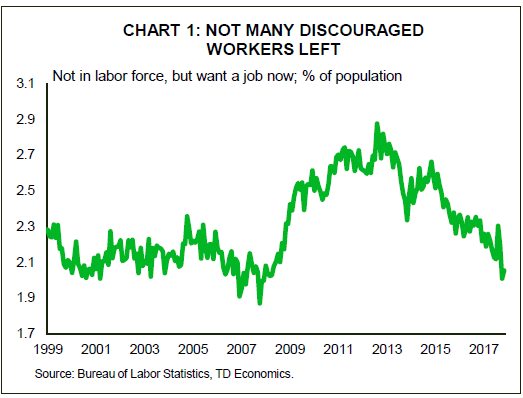
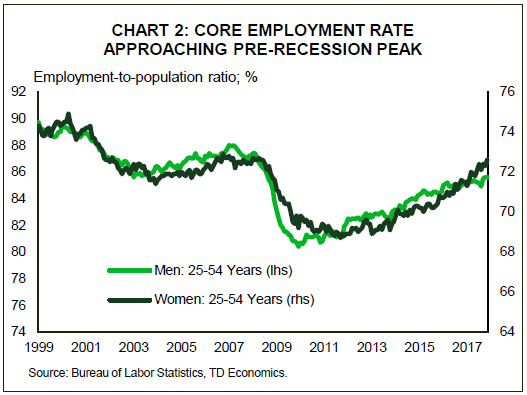
Canada – BoC Stands Pat on Rates, But Statement Dovish
After last week’s bevy of data, and a blowout jobs report, this week was a little bit calmer. However, there were still a few key economic data releases on trade and housing to keep investors occupied, with a fireworks-inspiring starts report this morning. Still, the highlight of the week was arguably the Bank of Canada’s interest rate decision which, despite the consensus decision, left many scratching their heads and the loonie reeling.
Earlier in the week, the merchandise trade report indicated that Canada’s trade deficit narrowed to $1.5 billion in October, marking its lowest level since May (Chart 1). The narrowing was related to both a rise in exports (+2.7%) as well as a sizable drop in imports (-1.6%). In volume terms, exports also increased while imports declined. The bounce back in exports was welcomed, particularly in light of the extremely weak Q3 performance. Overall, the improvement in the trade balance sets up for net exports to make a positive contribution to growth in the fourth quarter.
Canada’s housing market was also thrust into the spotlight this week, thanks to a trio of releases. October’s permitting data showed residential construction intentions slowing (Chart 2), continuing a recent trend and pointing to some moderation in activity. However, that moderation is not yet upon us, with housing starts data for November indicating that builders broke ground on a whopping 252k homes (in annualized terms) (Chart 2). The increase was led by the multifamily segment, with Toronto starts surging 28k to 45k while Vancouver’s pulled back 3k to 32k. The same pattern showed up in housing resales data for Toronto and Vancouver from their respective real estate boards, with the sales increase in Toronto providing further evidence that the market is shrugging off the recent policy-induced turbulence.
Arguably, the biggest event on the economic calendar in Canada this week was the Bank of Canada’s decision on interest rates. The Bank held rates steady, as largely expected, though the sharply dovish slant in the accompanying statement was a bit of a head-scratcher. The reference to "labour market slack" was particularly surprising after Friday’s LFS report which showed that the unemployment rate dropped to the lowest level in nearly ten years in November. The cautious tone, which threw cold water on near-term hikes, led the Canadian dollar to sell off by nearly 1% in the wake of the Bank’s communication.
The Bank gave a nod to improving data, given its upbeat assessment of the economy and indicated that higher rates would likely be required over time. At the same time, the Governing Council chose to be extremely patient, noting that they will be "cautious" and "guided by incoming data" before any rate hike occurs. Given that the economy is effectively becoming one of excess demand and growth expected to exceed the BoC’s projection in the fourth quarter of this year, we believe the case for higher rates remains intact. And while a January hike is not without merit, the recent dovish tilt by the Bank of Canada suggests that the next hike may not come until later in the quarter and maybe as late as spring time.
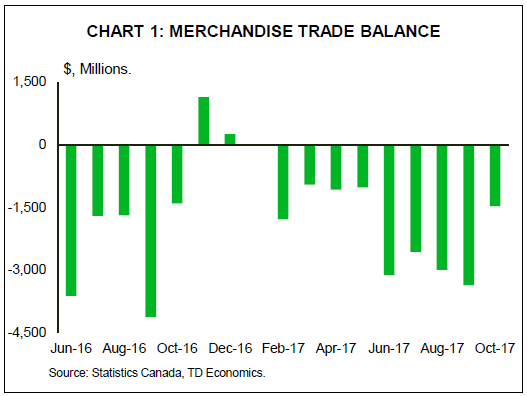

U.S.: Upcoming Key Economic Releases
U.S. Consumer Price Index – November
Release Date: December 13, 2017
Previous Result: 0.1% m/m
TD Forecast: 0.4% m/m
Consensus: 0.4% m/m
We expect headline CPI inflation to firm to 2.3% y/y in November, with prices up 0.4% m/m. Energy prices should be a net positive, helped by higher gasoline prices, while continued subdued gains in food prices cannot be excluded. Base effects for the latter, however, still point to a y/ y acceleration. Excluding food and energy, we expect core CPI to print a 0.2% m/m increase. A key driver is core goods prices, which in the prior month posted its first m/m increase since January. We believe another m/m gain is possible on the back of firming import prices, keeping the core inflation rate stable at 1.8% y/y.
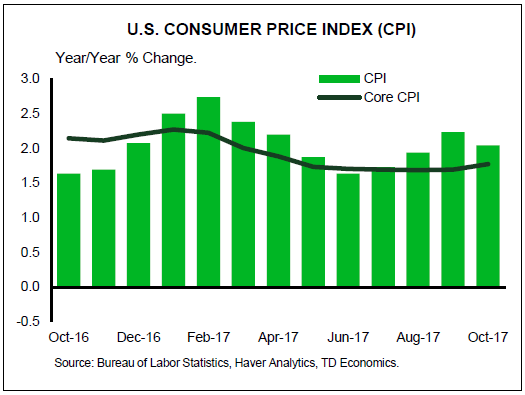
U.S. Retail Sales – November
Release Date: December 14, 2017
Previous Result: 0.2%, ex-auto 0.1%
TD Forecast: 0.2%, ex-auto 0.6%
Consensus: 0.3%, ex-auto 0.7%
We expect retail sales to rise 0.2% in November, consistent with Q4 real consumer spending at a pace slightly above 2%. Motor vehicle sales are likely to be a drag, in line with the continued moderation in light weight auto and truck sales after Hurricane Harvey boosted sales substantially in September. Offsetting increases should be found in gasoline station receipts, on higher gasoline prices, along with a modest rise in the control group (excluding auto, gasoline station, food services and building material sales). We are cautious to take any signal from holiday shopping reports, which were upbeat for online sales and relatively bearish for in-store sales. If anything, risks skew to the downside based on the strength in the prior two months, and we look for a 0.2% increase in this category. Our forecasts would still leave Q4 real consumer spending tracking above 2%.
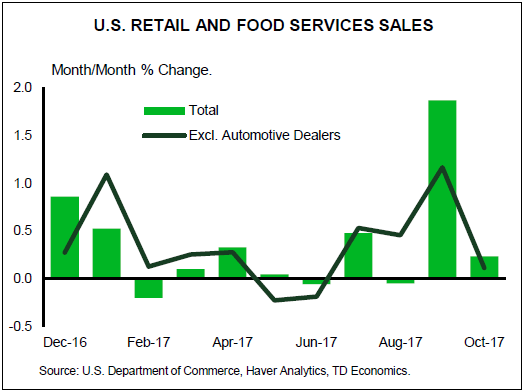
Canada: Upcoming Key Economic Releases
Canadian Manufacturing Sales – October
Release Date: December 15, 2017
Previous Result: 0.6% m/m
TD Forecast: 1.0% m/m
Consensus: N/A
We expect Canadian manufacturers to head into Q4 on a decent note. Headline manufacturing sales should rise 1.0% m/m, reflecting a sharp increase in factory prices whereas volumes should underperform. Labour disruptions will continue to weigh on motor vehicle production and a correction of the outsized gains in other transportations categories (i.e., aerospace, railroad, and "other") will provide a headwind. Petroleum shipments should rise on foreign demand while a pickup in refining activity will support shipments of chemicals used in the process. Overall, manufacturing should make a positive, albeit muted, contribution to October GDP, though we expect a strong print in November on a rebound in motor vehicle output.
